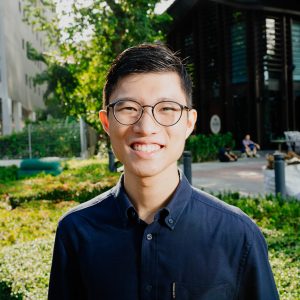Medicine is traditionally thought of as an applied science; but is it more than just a cold, calculative science based largely upon objective data? Diploma Programme (DP) graduate Aaron Goh Qi Yang shares his perspective on how the two contrasting worlds of art and science collide in his clinical practice. This is his second story in our graduate voices series.

“Medicine is both a science and an art—the science is in the details; the art is in the delivery”
As a young and impressionable pre-IB student at 16 years old, it was commonplace to see my friends apply labels to themselves: “oh, I’m more science-inclined …” and yet another, “I’m more of a humanities student”. In my years through IB and early university, it became apparent that fabricating these artificial barriers would only hinder me from realizing the intimate relationships between contrasting disciplines of sciences and the arts.
Some would say that I had an affinity for the sciences; a passion that was carefully honed by the patient guidance of my teachers. It therefore seemed natural to pursue a course of higher education that would marry this passion for the sciences with my desire to help people in practical ways. Thus, by a combination of unmerited Grace and circumstance, I soon found myself donning a crisp white coat and reciting the declaration of a new medical student.

Science
Yet shortly after making that oath, I found myself asleep at the hands of an immunology textbook. This was not a great start to school! We began with a module so aptly titled “Introduction to Medical Sciences” and studied the intricacies of human cells. We considered the molecular mechanisms that whirred quietly in the background of our bodies, giving thought to these complex systems whose existence we were previously unconscious of.
No matter how beautifully designed these systems were, all this ‘science’ wasn’t quite my speed—the days were spent memorizing details and pouring over minutiae that was, frankly, uninspiring. I echoed the lamentations of a fellow physician who wrote: “the concept of artful medicine remained a haunting mystery that simmered below the avalanche of medical facts and disease processes I had to learn.”
Language
I soon entered the 3rd year of medical school, stepping into a brand-new learning environment. Classes were conducted not in classrooms but rather in the hospitals. Patients became our teachers. In this transitional year, I felt that the study of medicine was akin to acquiring a new language. I often marveled at the way my seniors and professors were speaking, as if they were members of an exclusive society to which I was slowly being granted access into. Technical jargon rolled off their tongues almost effortlessly (ever tried pronouncing ‘oesophagogastroduodenoscopy’? Getting my tongue in a knot became a familiar feeling!). In the cacophony of speech that I did not yet understand, vital information was being communicated—details of patients’ infirmities, drug names and doses. Yet what impressed me most was seeing how those same clinicians, who just moments ago were speaking a language bordering on foreign, were able to simplify that same information for their patients. This, to me, represented the pinnacle of communication excellence, and by no means is this a simple feat. Communication was an art to be mastered over our years of training; another tool we could tuck away in the repository of our minds.
Uncertainties
“Medicine is a discipline of duality—it stands at the crossroads between life and death, requires competency both in people skills and decoding data and encompasses the full spectrum of human emotions … ”
This was also the year where the art of medicine became increasingly evident; where science and logic would not hold water in the face of diagnostic uncertainties. On one occasion, a young lady presented to the emergency department with non-specific abdominal pain and despite a full workup the source of pain was unidentifiable. Three days later, the disease revealed its true colours, evolving to become a colicky right upper quadrant pain with raised bilirubin and inflammatory markers, consistent with an inflamed gallbladder (cholecystitis). How would anyone have been able to diagnose a cholecystitis on day 1? This was one of the most non-textbook presentations of cholecystitis I had seen. A senior jokingly suggested that ‘diseases don’t read their textbooks’, yet he did not realize the great amount of truth in his words.
Style
Just as how each artist has a trademark style that defines their unique work, such is the case in medicine; with different doctors advocating their personalized, unique approach to patient communication. One example that comes to mind is seeing the different ways doctors demonstrate empathy—some listen without interrupting, others express compassion through their words, still others offer a sincere touch. Some use a combination of all three!
Variations in styles exist in the physical examination as well. Another doctor gently corrected me as I was taking a patient’s pulse: “your technique works well, but this would look more professional,” he said, taking the patient’s hand as though in a handshake and gently pressing the pulps of his fingers against the incessant drumming of this patient’s radial pulse. A collective exclamation of awe escaped our lips, impressed by the finesse that this clinician demonstrated. Such mastery could only be borne through years of honing his craft.
I consider myself undeservingly blessed to be working in a field where two contrasting disciplines intersect. In many ways, medicine is a discipline of duality—it stands at the crossroads between life and death, requires competency both in people skills and decoding data and encompasses the full spectrum of human emotions between joy and sorrow. And this is why the practice of medicine is both a science and an art—the science is in the details; the art is in the delivery. And I am thankful that I never quite lost that artistic flair in me, for it has helped me become the holistic and effective healthcare professional that I am today.

Aaron Goh Qi Yang graduated from the IB DP at Anglo-Chinese School (Independent), Singapore, in 2015. He reads Medicine at the Lee Kong Chian School of Medicine, Singapore. An accomplished medical student, his team emerged world champions at the inaugural Elsevier ClinicalKey Global Challenge in 2019, and his research has been presented in conferences both locally and overseas. You can connect with him here and @aarongohqy.
To hear more from Diploma Programme (DP) graduates check out these IB programme stories. If you are an IB grad and want to share your story, write to us at alumni.relations@ibo.org. We appreciate your support in sharing IB stories and invite you to connect with us on LinkedIn, Twitter and now Instagram!
If you enjoyed this story, consider reading more below:



